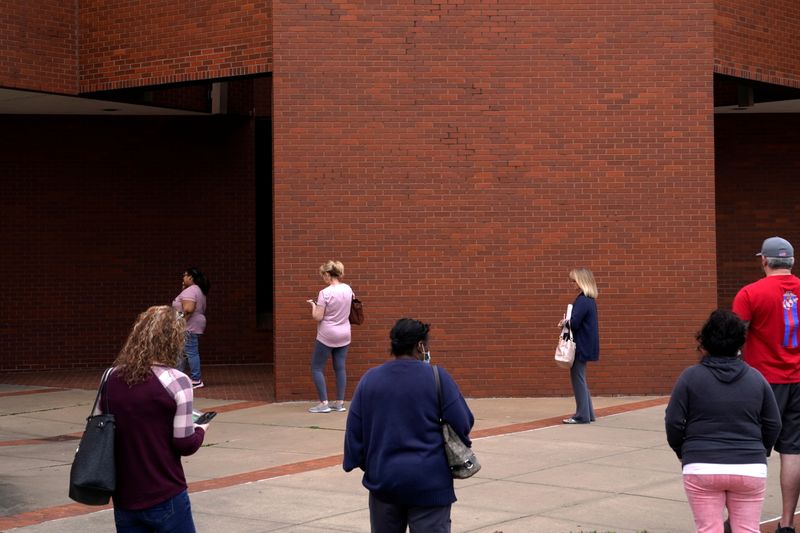WASHINGTON (Reuters) – Layoffs in the United States fell in April, but remained the second highest on record, while hiring hit an all-time low, suggesting the labor market could take years to recover from the COVID-19 crisis despite a surprise rebound in employment in May.
The report from the Labor Department on Tuesday also showed a decline in job openings as the economy battles a recession triggered by the pandemic. The National Bureau of Economic Research, the arbiter of U.S. recessions, declared on Monday that the economy slipped into recession in February.
“We may continue to see elevated rates of layoffs and job cuts continue to spread to other sectors, but the tidal wave of layoffs appears to be behind us,” said Nick Bunker, research director at Indeed Hiring Lab. “The labor market has a lot more progress to make.”
The monthly Job Openings and Labor Turnover Survey, or JOLTS, showed layoffs and discharges dropped 3.8 million in April to 7.7 million. That was second highest level since the government started tracking the series in 2000.
Prior to the pandemic, layoffs hovered around 1.8 million. They are nearly three times the worst month of the Great Recession. The layoffs and discharge rate fell to 5.9% in April from a record high 7.6% in March.
The labor market was slammed by the closure of nonessential businesses in mid-March to slow the spread of COVID-19. Many establishments reopened in May, with the economy adding a stunning 2.509 million jobs last month after a record 20.7 million plunge in April, government data showed on Friday.
Economists warn it could take even a decade for the labor market to recoup the jobs lost during the COVID-19 recession. The NBER does not define a recession as two consecutive quarters of decline in real GDP as is the rule of thumb in many countries, instead it looks for a drop in economic activity, spread across the economy and lasting more than a few months.
A separate report from the Commerce Department on Tuesday showed a modest increase in wholesale inventories in April that was likely to be eclipsed by a plunge in stocks at retailers, suggesting inventory investment could again be a drag on economic output in the second quarter.
Economists expect gross domestic product could decline at as much as a 40% annualized rate in the second quarter, which would the largest drop in GDP since the Great Depression.
Stocks on Wall Street were mixed after strong gains in the previous sessions, with investors awaiting the Federal Reserve’s assessment of the economy at the end of the U.S. central bank’s two-day policy meeting on Wednesday. The dollar fell against a basket of currencies. U.S. Treasury prices rose.
HUMAN SUFFERING
The Labor Department report showed big decreases in layoffs in the accommodation and food services and retail trade. Layoffs, however, increased in the construction, information and wholesale trade industries.
Hiring tumbled 1.6 million to a record low 3.5 million in April. The hiring rate plunged to an all-time low of 2.7% from 3.4% in March. Hiring decreased in many industries, with the biggest declines in professional and business services, accommodation and food services and construction.
Hiring was around 5.9 million each month before COVID-19.
“The human suffering and lost productive potential represented by these numbers is immeasurable,” said Heidi Shierholz, a former chief economist at the Labor Department and now head of policy at the Economic Policy Institute in Washington.
Job openings, a measure of labor demand, declined 965,000 to 5.0 million on the last business day of April, the lowest since December 2014. The decline in job openings was concentrated in the professional and business services, healthcare and social assistance and retail trade industries. Government vacancies dropped by 82,000 jobs.
The job openings rate dropped to 3.7%, the lowest since January 2017, from 3.8% in March. Vacancies peaked at 7.52 million in January 2019. There were 4.6 unemployed workers for every job opening in April.
“Many of these jobs may have been posted a few months back and this isn’t necessarily an opportunity for those who lost their employment in the pandemic recession,” said Chris Rupkey, chief economist at MUFG in New York.
The number of people voluntarily quitting their jobs dropped one million to 1.8 million, the lowest since January 2010. The quits rates, which is viewed by policymakers and economists as a measure of job market confidence, fell to a nine-year low of 1.4% from 1.8% in March.
(Reporting By Lucia Mutikani; Editing by Andrea Ricci)

























